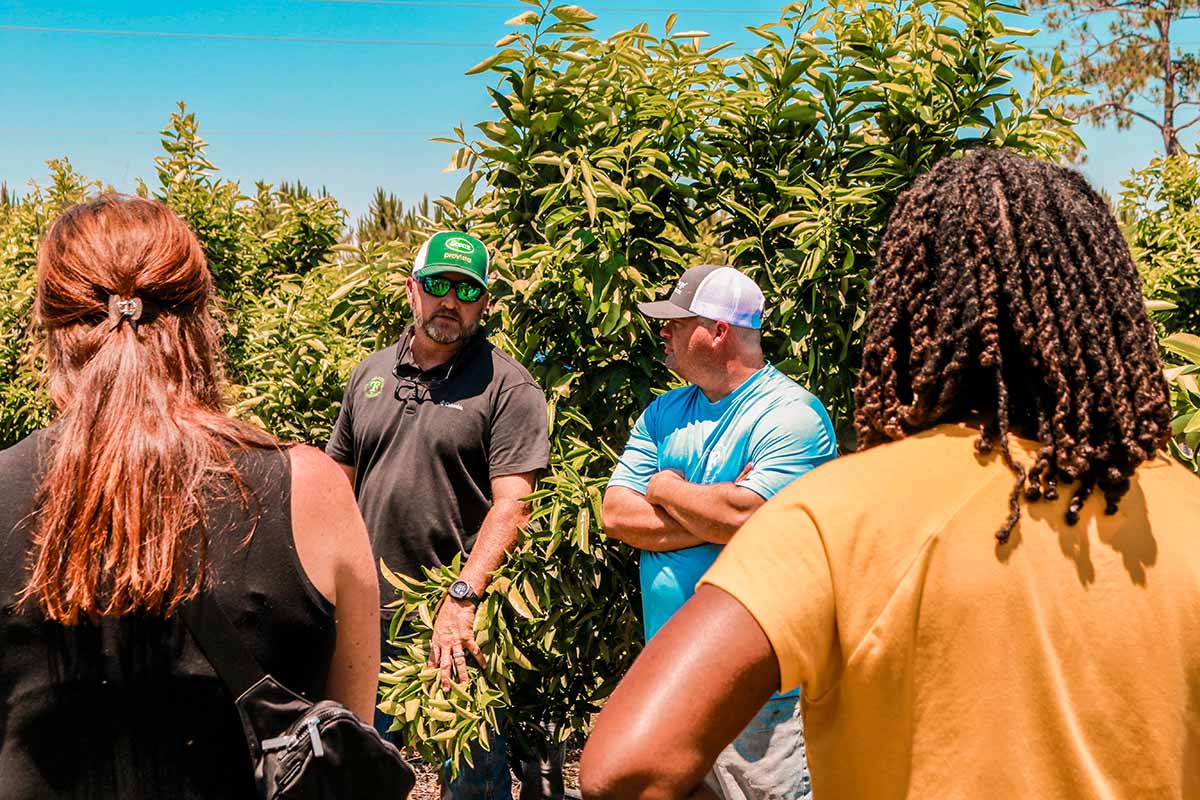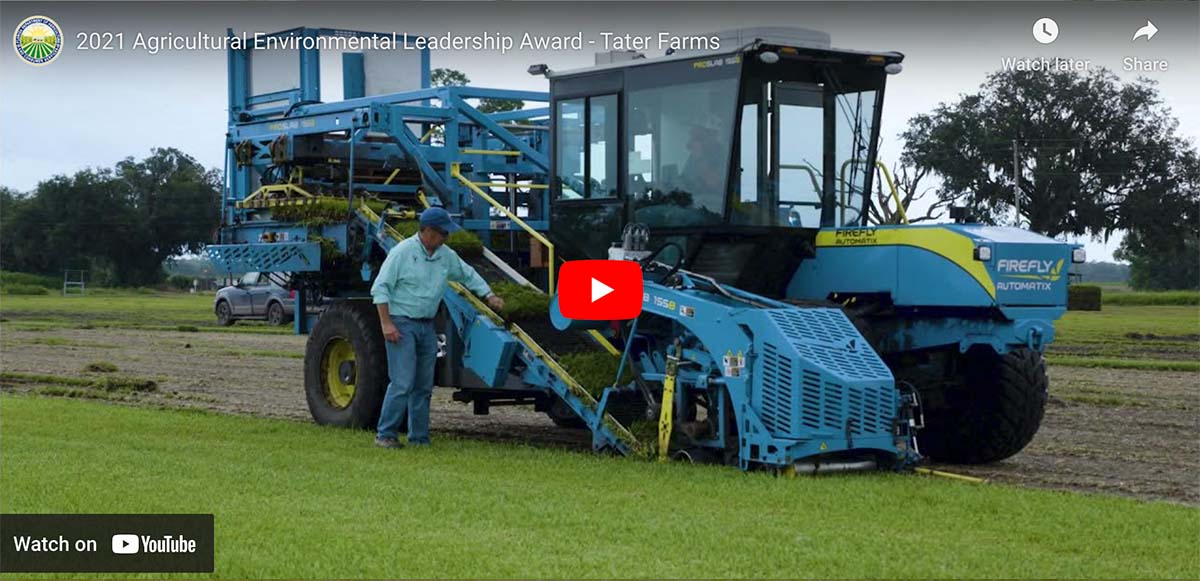Eric Hjort and Gage Hjort, PhD with their FireFly electric autonomous AMP mower (photo courtesy of Tater Farms)
Tater Farms has been a customer of FireFly Automatix for ten years, during which time its leaders have not only observed the evolution of the company’s technology but also contributed to its development. A highlight of their partnership came nearly a year ago when the farm acquired the first production model of FireFly’s AMP-L100 electric autonomous mower. From their initial automated harvester to their current fleet of harvesters and robotic mowers, Tater Farms has thrived by embracing FireFly’s automation solutions.
Tater’s Roots
Innovators to the core, the Tater Farms leadership has always worked to be on the cutting edge of technology. Frank Johns grew up on a well-established family farm, but in 1975 he started his own farm in Hastings, in Northeast Florida. He started in row crops—farming potatoes and cabbage—and named the farm after its primary crop. Frank was a pioneer in the use of auto-steer technology and was admired for having the straightest rows of potatoes in Florida.
When Johns pivoted from cabbage to turfgrass in 2005, he brought in expert Eric Hjort to coach his team on farming this new crop. Within two years, Eric was hired as the farm manager, and with a successful build-up of their turf segment, they converted the rest of the farm to grass in 2011.
Making the Automation Leap with FireFly
Harvesting their turfgrass required several people to perform physically demanding labor, making it difficult to find enough staff. To address this challenge, Frank and Eric started exploring new automated harvester options.
When Eric first saw a ProSlab harvester from FireFly, he immediately recognized its technical superiority. Eric recalled that the FireFly was faster and more capable of picking up slabs and stacking them in different conditions. He remembered a demo day in “the worst grass,” where other automated machines in the field were not able to get the grass on the pallet, and the FireFly “just walked down it and stacked all the grass.” He continued, “Even today, they’ve never come close to FireFly. Nobody’s been able to replicate what these guys have done.”
Frank and Eric were originally drawn to the promise of labor savings, and together they decided to purchase a harvester from the fledgling company from Utah. Unfortunately, they lost Frank to ALS soon afterwards, so he wasn’t there to see that plan come to fruition, but his idea has grown into a longstanding partnership with FireFly that has helped the farm to grow and flourish.
One of several FireFly ProSlab sod harvesters at work at Tater Farms in Northeast Florida
In 2014, Tater Farms purchased FireFly’s ProSlab harvester #10. They admit that the early machines came with some challenges, but they appreciate the timely support that the FireFly team always provides. Eric recalled FireFly founders Steve and Dan Aposhian making overnight flights to be at Tater the next day to help them solve any issues they were having.
As FireFly has grown in the following decade, their service team has expanded. Gage Hjort, PhD, Technology Manager for Tater Farms, said FireFly’s customer support is “definitely what sets them apart,” whether it’s support from their regional technician, their bilingual help desk, or the autonomy engineers themselves.
Focused on Product Improvements
Eric added, “Based on our experience with FireFly’s customer service, I tell Gage there’s going to be a solution to any problem we’re having, because they are focused on making sure the product gets better.”
Eric has witnessed those product improvements firsthand, as the farm has upgraded their equipment over the past ten years. They have purchased 13 FireFly automated harvesters over the decade, selling five older machines to replace them with newer models. They now operate four ProSlab 155B’s and four ProSlab 160’s, as well as two autonomous mowers.
Over the years, Eric and his team have given ideas and feedback to FireFly that have helped improve the machines. For example, FireFly decided to use the same chains from Broekema that Tater had been using on their potato harvesters after observing them in action on Tater’s farm.
Eric commented, “The machines out there today are just incredible.”
An Automated Fleet as a Force Multiplier
Over the past decade, workers have been harder and harder to come by, and their automated equipment has had an increasingly important impact on their farm. Pat Ditto, Harvest Manager, described their FireFly machines as a “force multiplier.”
“As manpower gets harder to find, that force multiplier becomes more and more important.”
Pat described the efficiency compared to hand-stack harvesters: “You have one guy doing the work of three guys, and you’re doing it faster, and you’re doing it, generally, better. The pallets will come out looking better. The field, at the end of the day, will come out looking better.”
Pat Ditto with one of the FireFly turfgrass harvesters at Tater Farms (photo courtesy of Tater Farms)
Getting More out of their Fields
Eric also brought up the increase in yield that FireFly harvesters bring—a benefit the team had not anticipated at the beginning. “Our hand-stack machines cut a 16-inch-wide by 24-inch piece of sod, where FireFly cuts a 24-inch-wide piece of sod (16-inch long).”
Pat added, “There’s a lot of good stuff the FireFly [harvests] that the hand-stack machine doesn’t. It’s truly impressive to watch a FireFly harvester after you watch a hand-stack team.”
Because they leave a ribbon of uncut grass between each harvested strip, the wider pieces on the ProSlab machines allows for a higher yield with no impact on grow in.
And when your crop sells by the square foot, higher yield directly translates to profits.
Continuously Growing and Innovating
As their automated fleet of FireFly turf harvesters grew, Tater Farms expanded from their original 200 acres of sod to managing 6500 acres—3000 acres of improved grasses and 3500 acres of bahia grass. In 2018, the farm also diversified by introducing a new crop: Juicy Crunch tangerines. They now have 225 acres of tangerines, with a plan to increase to 750.
Jake Brown and Justin DeVane with visitors in the tangerine groves at Tater Farms (photo courtesy of Tater Farms)
In addition to expansion, Tater Farms has also continued to innovate in other ways. The group was recognized in 2021 with the Agricultural Environmental Leadership Award from the Florida Department of Agriculture and Consumer Services (FDACS). The FDACS praised the company for its irrigation systems that had decreased their annual water usage by over thirty-four million gallons. The FDACS report also noted: “Turning to an automated harvesting system, Tater Farms has addressed one of the biggest concerns facing agriculture today, labor.”
Leading Out with Autonomous Mowers
Speaking of labor, Gage pointed out that mowing is another task that is hard to keep staffed. The farm mows their mature grass about two to three times each week. Progressive as always, the team at Tater Farms turned to fully autonomous solutions to meet their growing labor challenge.
“It’s kind of how we’re wired. Mowing is a routine task that eats up a lot of labor time, so the autonomous mowers really help out with that—to free up time for people to work on other things.” – Gage Hjort, PhD
The farm took delivery of their first unmanned mower in the summer of 2023. The FireFly M220-AV features a 21-foot wide cut, built for large expanses of grass like those found on a sod farm.
Originally, the M220-AV’s autonomy operated in a “teach-and-repeat” method. During the initial setup, an operator would drive the mow pattern in “teach” mode, and the mower would store the path for future “repeats” without an operator. However, FireFly has since updated the M220’s software to use optimized planning with their QuickPlan™ program, another example of the company’s commitment to continuous improvement.
Gage Hjort, PhD driving the FireFly AMP-L100 reel mower at Tater Farms (photo courtesy of Tater Farms)
In early 2024, the Tater team added another FireFly robotic mower to their line-up: the AMP-L100. Building on FireFly’s pioneering use of electrically-driven systems, this 100-inch reel mower is fully electric, powered by a 48-Volt Lithion Iron Phosphate (LFP) battery.
Although some advantages of the robotic mowers are being realized, the Tater team sees greater potential to scale those benefits with more machines. Eric envisions more efficiency with 4 or 5 AMPs monitored by one person. That way, more of the field could be covered on a single charge.
Top-Quality Mowing Results
On a typical day when both autonomous mowers are being used, Gage gets them going and then he’s free to work on other tasks. When he retrieves the machines, he notices a higher quality mowing finish, particularly from the AMP’s reel cut.
“The difference in the quality of cut is definitely noticeable—actually cutting the blade instead of tearing the blade of grass. When you look out across a nice clean field, even the M220 will sometimes have stripes in the field, like a ball field. It just makes it look really professional.”
Pat agreed, “Coming behind the M220 specifically, your three decks are all generally cut at the same height. It’s even all the way across, and the cuts are very clean. It makes for a really nice slab of grass when you put it on a pallet.” He added, “With other mowers, they’re hitting a little different, and you’ll get highs and lows in the field, so the overall quality’s not as good.”
Gage Hjort, PhD; Pat Ditto; and Eric Hjort with an automated ProSlab harvester from their fleet (photo courtesy of Tater Farms)
Looking to Scale
Tater Farms will undoubtedly continue to push the turf production industry forward in their implementation of technology, and the FireFly Automatix team is humbled to partner with them in this effort.










